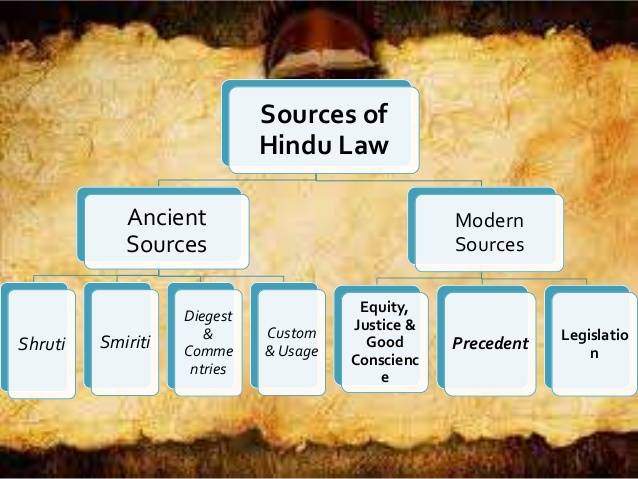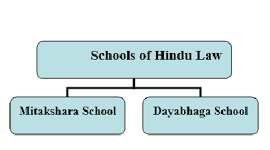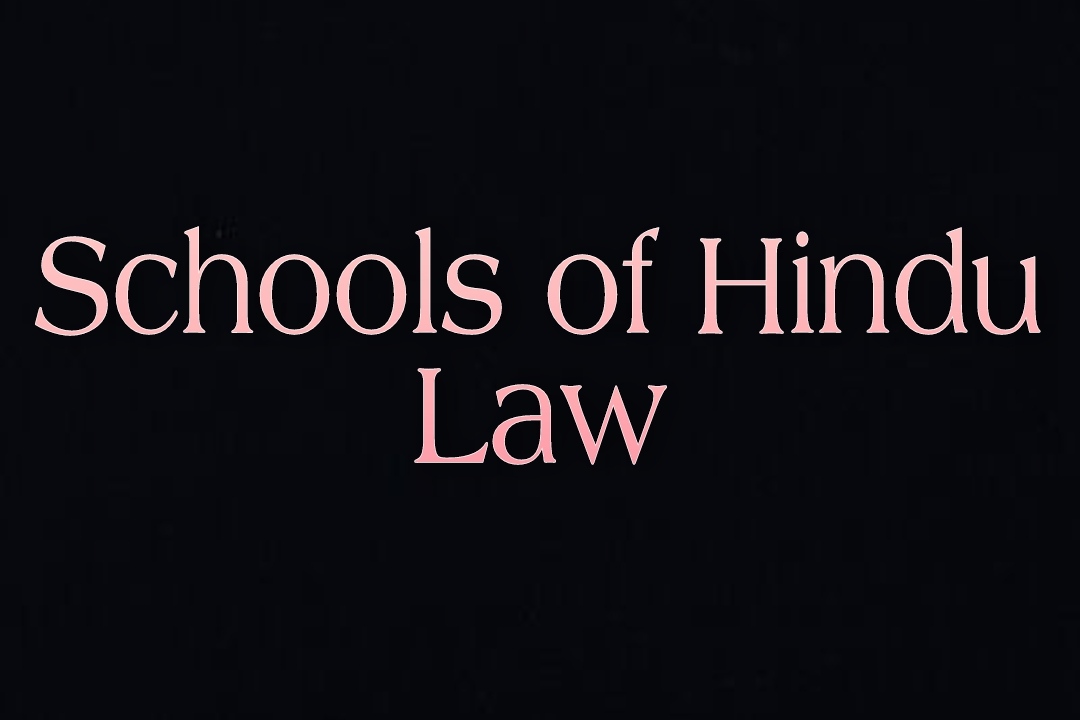Introduction
The Hindu Law of School is the most ancient in the world. The main purpose of its establishment was to attain salvation and fulfill everyone’s needs. It was initiated for the welfare of people. The Hindu Law of School is considered to be 6000 years old. Gradually it was replaced by modern Hindu law which included judicial decisions, statutory enactments, justice, equity, and good conscience. Hindu law is classified under two sources as follows:
- Ancient Sources
- Modern Sources
- Ancient Sources: The Shruti or Vedas, Smritis or Dharmashastras, Commentaries & Digests, and Custom and Usages are included under ancient sources. These sources are very old and have been prevalent in our society for over 6000 years. Before modern sources, these sources were only considered as the main source of Hindu Law. Even today, Hindu law consists majorly of ancient sources.
- Modern Sources: The legislation, judicial decision (precedents) and justice, equity, and good conscience are included under modern sources of Hindu law. These sources were not initially added, they evolved and became a part of Hindu law.
Sources Of Hindu Law

- The Shrutis or Vedas
The shrutis are considered to be the primary source of Hindu law. The word “Shrutis” means what is heard. Shrutis or Vedas are considered to be heard by the inspired ages. The Shrutis consists of four Vedas:
- Rigveda
- Yajurveda
- Samveda
- Atharvaveda
The oldest Veda is Rigveda and it consists of hymns and songs in praise of the forces of nature. The Yajurveda consists of rituals and sacrifices in this connection. The Samveda deals with a prayer composed in meter and set to music. The Atharvaveda deals with magic, spells, and incantations. The Vedas are supposed to be the fundamental principles of Hindu law.
- The Smritis or Dharmashastras
The word “Smritis” means “what is remembered”. It was created by inspired sages and is based on the texts of the Vedas. The Smritis believe that human agency is the declaration of the law, substantive as well as procedural. Manu’s Smriti is the most important. The Smritis are of two kinds:
- Dharma Sutras
- Dharma Shashtra
Dharma Sutras are concise in expression and have a general principle of common sense and justice. They fall into 3 classes:
- The Srauta Sutras (dealing with rituals)
- The Griha Sutras (dealing with domestic ceremonies)
- The Dharma Sutras (dealing with the law)
- The Puranas
The Puranas are codes that illustrate law by giving examples of its application. They are considered occasionally authoritative. Though sometimes they are not considered authoritative on the law.
- The Commentaries and Digests
Commentaries are an explanation of Sutras and Shlokas and Digests are a compilation of all the relevant material from different sources on the law. The two principal commentaries are
- Mitakshara
- Dayabhaga
- Custom and Usages
Customs and Usages have played a vital role in shaping Hindu law. They have special significance under Hindu law. Hindu law originated from customs. With time, they were defined and reshaped by great sages. The Custom has an upper hand if any disagreement arises between Custom and Smriti.
- Legislation
The modern source of law has equal importance in the evolution of Hindu law. Before this, the Hindu law was scattered. Codification was necessary for the evolution of Hindu Law. In 1976, for the first time, the concept of divorce by mutual consent was introduced under the Hindu Marriage Act, 1955.
- Judicial Decisions (Precedent)
Precedents are judicial decisions that the court of law is bound to follow for future cases. Legislation and judicial decisions are not sources of law, they supplement Hindu law. They have developed over time as an important source of law and contributed to the growth of Hindu law.
Schools Of Hindu Law

Schools of thought are the commentaries of the smritis. With time, they have widened the scope of Hindu law and contributed to the evolution of Hindu law. In codified law, the concept of schools of Hindu law does not exist. However, it does exist in uncodified law and has impacted the mind of lawmakers in various ways. The rules and regulations of Hindu law are not the same all over India as people have different opinions on different subject matters. There are two schools of Hindu law:
- Mitakshara School
- Dayabhaga School
Both schools are considered equally important under Hindu and they have given required information on the present legislated laws.
The Mitakshara School
Mitakshara is one of the most important schools of Hindu law. Except for Weast Bengal and Assam, it is applicable in the whole of India. It is a running commentary of the Smriti written by Yajnvalkya. Though the Mitakshara school has very jurisdiction, different customary laws are practiced in different parts of the country. It is further divided into five different sub-schools namely as following:
- Benaras Hindu law school
- Mithila law school
- Maharashtra law school
- Punjab law school
- Dravida or madras law school
These law schools enjoy the same fundamental principle but it differs in certain circumstances. They all come under the ambit of the Mitakshara School of Hindu law
Benaras Hindu Law School
This law school under Mitakshara school covers all northern India including Orrisa. Some of its major commentaries are Viramitrodaya, Nirnyasindhu, and Vivada. The Benaras Hindu law school is considered the most orthodox school under Hindu law.
Mithila Law School
This law school under Mitakshara covers the territorial part of Tirhoot and north Bihar. Its principles prevail in the north. Vivadaratnakar, Vivadachintamani, and Smritsara are the major commentaries of Mithila law school. The Kalpataru by Lakshmidhara is a work that is freely cited by the exponents of the Mithila School.
Maharashtra Law School
The Maharashtra law school exercises its jurisdiction over territorial parts of Gujarat Karana and the parts where the Marathi language is proficiently spoken. Vyavhara Mayukha and Virmitrodaya are the main authorities of Maharashtra law school.
Madras Law School
This law school under Mitakshara covers the whole southern part of India. Smriti Chandrika and Vaijayanti are the main authorities of Madras law school. Madras law school also exercises authority under Maharashtra law school.
Punjab Law School
This law school under Mitakshara covers the territorial part of east Punjab. It has its customs and traditions. Viramitrodaya and its established customs are the main commentaries of this school.
The Dayabhaga School
According to Ken, it was incorporated in Dayabhaga school predominately prevailed in Assam and West Bengal, except in one point in which the written law is at variance with the customs of the society. It owes its origin to Jimutvahana’s digest leading Smritis by the name of Dayabhaga. The primary focus of this school was to deal with partition, inheritance, and joint family. It was formulated to eradicate all the absurd and artificial principles of inheritance.
In Dayabhaga school, there are no sub-schools but there are various commentaries such as:
- Dayatatya
- Dayakram-Sangrah
- Virmitrodaya
- Dattaka Chandrika
How these Schools Came Into Existence?
In Hindu Jurisprudence, originally there was no school. Schools of Hindu law came into being through commentaries of smriti regarding different local customs of India. In the case of Rutcheyputty vs Rajendra, it was held that different schools of law were originated from different customs that were prevalent in India.
In the case of Collector of Madras vs Mootoo Rantalinga, it was held by the Privy Council that the sources of Hindu law (Smritis) are common to all the different schools but the processes by which these schools are developed are very different While incorporating different customs, the Smritis did not ignore the local customs and usages. There were conflicting doctrines, therefore the authority has been received in one and rejected in other parts of India.
Difference Between “Mitakshara” And “Dayabhaga” School Of Hindu Law
- Based on succession
In Mitakshara law school, the concept of inheritance is governed by the rule of consanguinity (blood relationship) and the Cognates are postponed to agnates. On the other hand, under Dayabhaga law school, the rule of spiritual efficacy governs the concept of inheritance. Under Dayabhaga school, some cognates like sister’s son are preferred over several agnates meaning if a Hindu dies leaving his son and his daughter behind, the son will inherit all the property and the daughter will be excluded from the inheritance. Under the Hindu Succession Act, 1956, there is one uniform law of succession for everyone.
- Based on Joint Family
In Mitakshara school, the right to property arises by his birth, and the son is considered as a co-owner in the ancestral property. He has a right to the joint family property from the moment he’s born. The father under Mitakshara school has limited power of separation of ancestral property. Whereas, in Dayabhaga school, the property right appears after the death of the last owner. The son has no right in his joint family property during his father’s lifetime. The father under Dayabhaga school has absolute power of separation for the ancestral property.
- Based on partition
In Mitakshara school, none of the members of coparceners can claim a definite physical share of the joint family. It involves holding the property in definite shares. On the other hand. In Dayabhaga school, each of the members of coparceners has a definite share in the joint family property. So, each coparcener has a separate share in the Hindu joint family property.
- Based on rights of woman
Under Mitakshara school, the wife cannot demand partition, however, she has a right to share in any partition affected between her husband and her sons. Whereas, under Dayabagha, the right does not exist for women as the father is the absolute owner. In both schools, the mother is entitled to an equal share to that of the son.
Landmark Judgements
Abdurahim v. Halimabai, 1915
In this case, the court held that when a Hindu family migrates from one place to another, they carry their law with them and if they are alleged to have become subject to a new local custom, this new custom must be affirmatively proved to have been adopted.
Balwant Rao vs Raji Rao, 1920
In this case, the Privy Council said that the commentaries interpret the law laid in the Smritis and recite the customs and usage founds in vogue around them. The commentaries do not enact the law but they interpret and explain the law.
Gurunath vs Kamlabai, 1954
In this case, the Supreme Court held that in the absence of any rule of Hindu law, the judges have the authority to decide cases on principles of justice, equity, and good conscience.
Luhar Amritlal vs Doshi Jayantilal, 1960
In this case, the court observed that judicial decisions have become part and parcel of the Hindu law as it is administered today. They play an important in shaping and evolving Hindu law and have a special significance and contribution.
Conclusion
The Hindu schools of law are considered the primary source of Hindu law. With time, it has emerged and developed with the help of modern legislation and precedents. It can be concluded that the Mitakshara school is a little conservative in nature as compared to the Dayabhaga school. The Dayabhaga school is more liberal and is considered the most important school of Hindu law. The major difference between the two schools is their thoughts of opinions towards the joint family property. Hindu law is considered the most ancient law, originally, it was created to satisfy every need and for the welfare of the people. The assets of Hindu law are Shruti (phrases of God), Smriti (text), customs (vintage practices), commentaries, and digest. These are not codified under Hindu law but they did hold special significance as the lawmakers used them in shaping and evolving Hindu law.
Frequently Asked Questions (FAQs)
What are the ancient sources of Hindu law?
The Shruti or Vedas, Smritis or Dharmashastras, Commentaries & Digests, and Custom, and Usages are included under ancient sources.
What are the modern sources of Hindu law?
The legislation, judicial decision (precedents) and justice, equity, and good conscience are included under modern sources of Hindu law. These sources were not initially added, they evolved and became a part of Hindu law.
Why is the case, Gurunath vs Kamlabai is considered significant under Hindu law?
In this case, it was held that in the absence of any rule of Hindu law, the judges have the authority to decide cases on principles of justice, equity, and good conscience.
What does Mithila school stand for?
This law school under Mitakshara covers the territorial part of Tirhoot and north Bihar. Its principles prevail in the north. Vivadaratnakar, Vivadachintamani, and Smritsara are the major commentaries of Mithila law school. The Kalpataru by Lakshmidhara is a work that is freely cited by the exponents of the Mithila School.
Name different commentaries under Dayabhaga school?
In Dayabhaga school, there are no sub-schools but there are various commentaries such as dayatatya, dayakram-sangrah, virmitrodaya, and dattaka Chandrika
How does custom play a vital role in Hindu law?
Customs and Usages have played a vital role in shaping Hindu law. They have special significance under Hindu law. Hindu law originated from customs. With time, they were defined and reshaped by great sages. The custom has an upper hand if any disagreement arises between Custom and Smriti.
How precedents have shaped Hindu law?
Precedents are judicial decisions that the court of law is bound to follow for future cases. Legislation and judicial decisions are not sources of law, they supplement Hindu law. They have developed over time as an important source of law and contributed to the growth of Hindu law.
